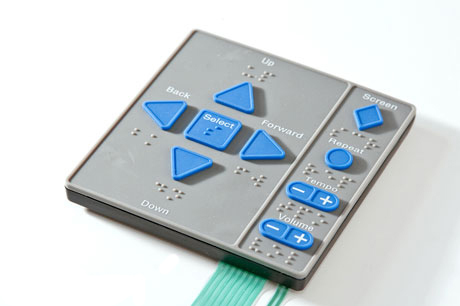Explore the Benefits of Using a Membrane Switch in Modern Devices
Explore the Benefits of Using a Membrane Switch in Modern Devices
Blog Article
Recognizing Membrane Layer Changes: The Key to Resilient and Reputable Controls

What Are Membrane Buttons?
Membrane switches are a sophisticated option in the realm of interface technology, combining performance and design seamlessly. These gadgets act as an interface between customers and digital systems, integrating a number of parts into a portable format. Normally created from adaptable, slim layers of products, membrane layer switches are made to react to touch, enabling customers to communicate with equipment and electronic tools successfully.
The main aspects of a membrane switch include a printed circuit layer, graphic overlay, and a spacer layer that avoids unintended activation. The graphic overlay can be personalized to reflect brand name identification or user preferences, improving appearances while ensuring functionality. Membrane switches are generally utilized in different applications, consisting of clinical devices, customer electronics, and commercial devices, owing to their longevity and resistance to ecological elements such as moisture and dust.
One of the essential advantages of membrane switches is their capability to withstand damage, making them optimal for high-traffic atmospheres. In addition, they are light-weight and require very little area, enabling cutting-edge styles in item development. On the whole, membrane switches stand for a reliable and sensible selection for modern digital user interfaces, weding modern technology with user-centric layout principles.
Just How Membrane Layer Changes Job
The procedure of membrane switches over joints on a basic yet reliable system that translates individual input right into electronic signals. When a user presses the switch, the leading layer flaws, permitting a conductive component in the circuit layer to make call with an equivalent conductive pad on the bottom of the visuals overlay.
The layout of membrane switches can vary, but they usually include domes or tactile aspects to give feedback to the customer, boosting the total experience - membrane switch. The products made use of in membrane layer buttons, such as polyester or polycarbonate, add to their toughness and resistance to environmental aspects, including moisture and dust. In addition, the published circuits are normally enveloped, which safeguards them from deterioration with time.
Benefits of Membrane Switches

Additionally, membrane switches are recognized for their sturdiness. Built from robust materials, they are resistant to dirt, wetness, and physical wear, which significantly expands their life-span contrasted to typical mechanical switches. This durability makes them specifically appropriate for high-traffic environments and applications needing longevity.
An additional substantial benefit is the convenience of cleaning and upkeep. The smooth surface of membrane layer additional resources switches over lessens dirt buildup and is typically unsusceptible spills, making them ideal for settings that call for regular sanitization.
Furthermore, membrane layer switches use a streamlined account, causing a thinner design that can be integrated right into different devices without including bulk. This attribute not only boosts the aesthetic appeal but also contributes to a much more ergonomic product style.
Applications of Membrane Buttons
Flexible and easy to use, membrane layer switches find applications throughout a wide variety of sectors, including medical devices, consumer electronics, and commercial tools. In the medical area, these buttons are essential to devices such as diagnostic tools, client monitoring systems, and mixture pumps, where integrity and ease of cleansing are vital. Their capability to maintain and withstand harsh environments functionality makes them perfect for such applications.

In consumer electronic devices, membrane buttons are used in items like microwaves, washing equipments, and remotes - membrane switch. Their smooth layout permits instinctive interface, enhancing the total user experience while offering toughness and resistance to tear and put on
Industrial equipment additionally takes advantage of membrane switches, especially in control panels for machinery and automation systems. These switches offer security versus dirt and moisture, ensuring regular efficiency in challenging environments. Their personalized attributes enable suppliers to tailor them to details functional needs, enhancing efficiency and performance.
Choosing the Right Membrane Layer Switch Over
When selecting a membrane switch, it is important to think about different More Info variables that affect efficiency and suitability for particular applications. The key considerations include environmental problems, tactile feedback, toughness, and layout specs.
First, assess the operating setting; switches revealed to moisture, chemicals, or extreme temperature levels need specific materials to make certain longevity and functionality. Next, examine the requirement for tactile responses. Depending upon user communication, some applications might gain from a responsive reaction to validate activation, while others may like a non-tactile design for aesthetic reasons.
Toughness is an additional vital factor; membrane switches should be made to hold up against regular use, influences, and abrasion. Ensure the picked button can endure the expected lifecycle, particularly in high-usage scenarios.

Conclusion
In conclusion, membrane layer changes offer as important parts in the layout of dependable and sturdy control systems throughout different industries. The adaptability of membrane switches over permits for tailored solutions that satisfy details operational demands, strengthening their value in modern-day technology.
Membrane layer switches over stand for a vital Read Full Article element of modern interface design, blending performance with strength in different applications.Membrane switches are a sophisticated option in the world of individual interface innovation, integrating functionality and style flawlessly. Usually created from versatile, thin layers of products, membrane layer switches are made to respond to touch, making it possible for customers to interact with machinery and electronic tools effectively.
The design of membrane buttons can vary, but they typically incorporate domes or responsive aspects to offer comments to the customer, enhancing the overall experience.In final thought, membrane layer switches over offer as important elements in the layout of reputable and sturdy control systems throughout various markets.
Report this page